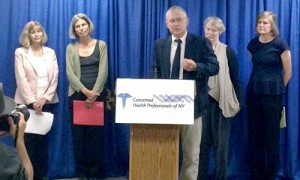Major Scientific Document Shows Why NY Fracking Moratorium Is Imperative
From EcoWatch.com, July 10, 2014
Less than two weeks ago, local communities triumphed over the fracking industry in a precedent-setting case decided by the New York Court of Appeals. The court ruled that the towns of Dryden and Middlefield can use local zoning laws to ban heavy industry, including oil and gas production within municipal borders.
While the court decision is a victory for the two towns, many New Yorkers continue to rally and push for a statewide fracking moratorium. In this vein, Concerned Health Professionals of New York (CHPNY) today released a major resource to the public, including public officials, researchers and journalists—the Compendium of Scientific, Medical and Media Findings Demonstrating Risks and Harms of Fracking.
Sandra joins with colleagues Sheila Bushkin-Bedient, MD, MPH, Michelle Bamberger, MS, DVM, Robert Oswald, PhD and Kathleen Nolan, MD, MSL, to present a major new compilation—a Compendium—of the scientific, medical and media findings demonstrating risks and harms of fracking.
“This compilation of findings brings together data from many fields of study and reveals the diversity of the problems with fracking—from increased flood risks to increased crime risks, from earthquakes to methane leaks,” said Sandra Steingraber, PhD, at a press conference held today. “What this multitude of threats all has in common is the ability to harm public health. That’s our message to Governor Cuomo and Acting Health Commissioner Zucker.”
As mounting evidence continues to find more costs than benefits to fracking, the compendium explains the motivation for compiling and making public the scientific, medical and media findings:
Despite this emerging body of knowledge, industry secrecy and government inaction continue to thwart scientific inquiry, leaving many potential problems—especially cumulative, long-term risks—unidentified, unmonitored and largely unexplored. This problem is compounded by non-disclosure agreements, sealed court records and legal settlements that prevent families (and their doctors) from discussing injuries. As a result, no comprehensive inventory of human hazards yet exists.
The compendium covers in detail the following 15 dangers, risks and associated trends created by the fracking process:
- Air pollution
- Water contamination
- Inherent engineering problems that worsen with time
- Radioactive releases
- Occupational health and safety hazards
- Noise pollution, light pollution and stress
- Earthquake and seismic activity
- Abandoned and active oil and natural gas wells (as pathways for gas and fluid migration)
- Flood risks
- Threats to agriculture and soil quality
- Threats to the climate system
- Inaccurate jobs claims, increased crime rates and threats to property value and mortgages
- Inflated estimates of oil and gas reserves and profitability
- Disclosure of serious risks to investors
- Medical and scientific calls for more study and more transparency
In light of these findings, referenced with more than 300 citations, and remaining fundamental data gaps, CHPNY considers a fracking moratorium “the only appropriate and ethical course of action while scientific and medical knowledge on the impacts of fracking continues to emerge.”
CHPNY sent the compendium to Gov. Cuomo (D), Department of Environmental Conservation Commissioner Martens and Acting Department of Health Commissioner Zucker. The group also sent a letter to Acting Commissioner Zucker requesting a meeting.
The compendium of dangers, available on the group’s website, is designed as a living document that will be updated every six months. The first edition is current through June 30, 2014.

